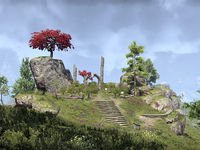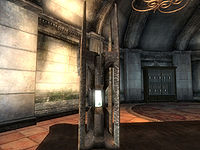Lore:Numerology
| To meet our site's higher standard of quality, this article or section may require cleanup. The user who placed this here had the following concern: Still a lot of expanding to do on this topic. To leave a message about the cleanup for this article, please add it to this article's talk page. |
—Swims-In-Deep-Water[1]
Numerology, the significance of specific numbers, is a subject of interest of elven culture.[2]
Paleonumerology is a subject of research mentioned alongside other fields like archeology and theology. In The Dragon Break Re-Examined paleonumerology is mentioned to have aided in disproving the existence of the Dragon Break was "invented in the late 3rd era, based on a scholarly error, fueled by obsession with eschatology and Numidiumism, and perpetuated by scholarly inertia."[3] The author of Shezarr and the Divines, Faustillus Junius, includes his title of the Subcurator of Ancient Theology and Paleonumerology for the Imperial Library in the book.[4]
Culture[edit]
Altmer[edit]
The Altmer are known for their reflections on sacred numbers,[5] and for establishing dedicated spaces, such as the Garden of Sacred Numbers, for their contemplation.[6] One such Altmeri philosopher pondered in this garden and ultimately consolidated his thoughts in his work Thoughts on the Sacred Numbers. In this anonymous book, the author argued that certain Sacred Numbers are considered Auspicious, as they are integral to the very essence of the universe. Three symbolizes the Number of the Prime Celestials, represented by the sun and the two moons. Five signifies the Number of the Elements, as reality is made up of Earth, Air, Water, Fire, and Aether. Eight represents the Number of the Planets and is also the sum of three plus five. It was also stated that these are the Good Numbers, and their total, Sixteen, is believed to be a number of great power. They also held that the Bad Number, Two, lacks vision and attempts to manifest duality, which is, as they believe, impossible.[5]
The Psijic Order had the means to scry secrets from fate lines beyond the bounds of Tamriel. Among these secrets were tomes that spoke of alternative timelines and realities, where certain key events transpired differently.[7] One of those tomes spoke of a reality where the Order detected a group of unknown entities who had been pushing through the Void to reach Nirn for centuries. They attempted to use the sacred strength of three, five to contain them, but none of them were able to. The Order sought aid to ascertain the nature of these beings, but in all cases the the Order found no answers. With no other option the Order gathered and formed endless nets of the Sacred Numbers out of threads of purest Magicka, hoping to repel the invading horrors. The entities were unlike any beast, Daedra or spirit the Order had ever seen. The smaller creatures were tangled in the net and fell back into the Void, but the largest gazed through the breach with a single great unlidded eye. Those who gazed upon the eye could not unsee and were unmade by the sight alone. Though the Order struggled until there was nothing left, the net eventually failed and the veil ripped asunder to allow the entities into the world, causing everything to be unmade by their arrival.[8]
Ayleid[edit]
Some scholars, such as Reginus Buca of University of Gwylim hypothesized that numerology was important in Ayleid civilization, just as it is was in modern Altmeri culture. It was based on the fact that eight lights were a common feature of some Ayleid chandeliers. It has also been said that upon his death Pelinal Whitestrake was cut into eight pieces as a 'mockery of the divine' and because the Ayleids were 'obsessed' with the number. Other academics, however, denied the connection to the divines and suggested that sixteen should actually be the number in order to honor their Daedric Pantheon.[2] Ten Ancestors was a group of idols that were significant to Ayleid's religion.[9][10]
Breton[edit]
Number three features frequently in Breton culture and history.[citation needed]
Dunmer[edit]
The Scripture of the Numbers[edit]
The Scripture of the Numbers is the primary topic of the 29th Sermon of the The Thirty-Six Lessons of Vivec. In the text a significance of each number from 1 to 36 is given. The numbers, with their associated significance, are:
- The Dragon Break, or the Tower.
- The Enantiomorph.
- The Invisible Gate, ALMSIVI.
- The Corners of House of Troubles.
- The Corners of the World.
- The Walking Ways.
- The Sword at the Center.
- The Wheel, or the Eight Givers.
- The Missing.
- The Tribes of the Altmer.
- The Number of the Master.
- The Heavens.
- The Serpent.
- The King's Cough.
- The Redeeming Force.
- The Acceptable Blasphemes.
- The Hurling Disk.
- The Egg, or Six Times the Wise.
- The Provisional House.
- The Lunar Lattice.
- The Womb.
- Unknown.
- The Hollow Prophet.
- The Star Wound.
- The Emperor.
- The Rogue Plane.
- The Secret Fire.
- The Drowned Lamp.
- The Captive Sage.
- The Scarab.
- The Listening Frame.
- The False Call.
- The Anticipations.
- The Lawless Grammar.
- The Prison-Shirt.
- The Hours.
A secondary set of numbers is present after each entry on the list. Associating that number with a specific word in the corresponding numbered entry in The 36 Lessons of Vivec reveals a message: "He was not born a god. His destiny did not lead him to this crime. He chose this path of his own free will. He stole the godhood and murdered the Hortator. Vivec wrote this."[11]
References[edit]
- ^ Fishing Mastery, v3 — Swims-In-Deep-Water
- ^ a b Eight-Star Chandelier antiquity codex entries in ESO
- ^ The Dragon Break Re-Examined — Fal Droon
- ^ Shezarr and the Divines — Faustillus Junius
- ^ a b Thoughts on the Sacred Numbers
- ^ Garden of the Sacred Numbers in ESO: Summerset
- ^ Tracker of Temporal Tomes achievement description in ESO
- ^ Garden of Sacred Numbers Temporal Tome
- ^ Umbacano's dialogue in Oblivion
- ^ Loriasel's loading screen in ESO
- ^ 36 Lessons of Vivec, Sermon 29 — Vivec

